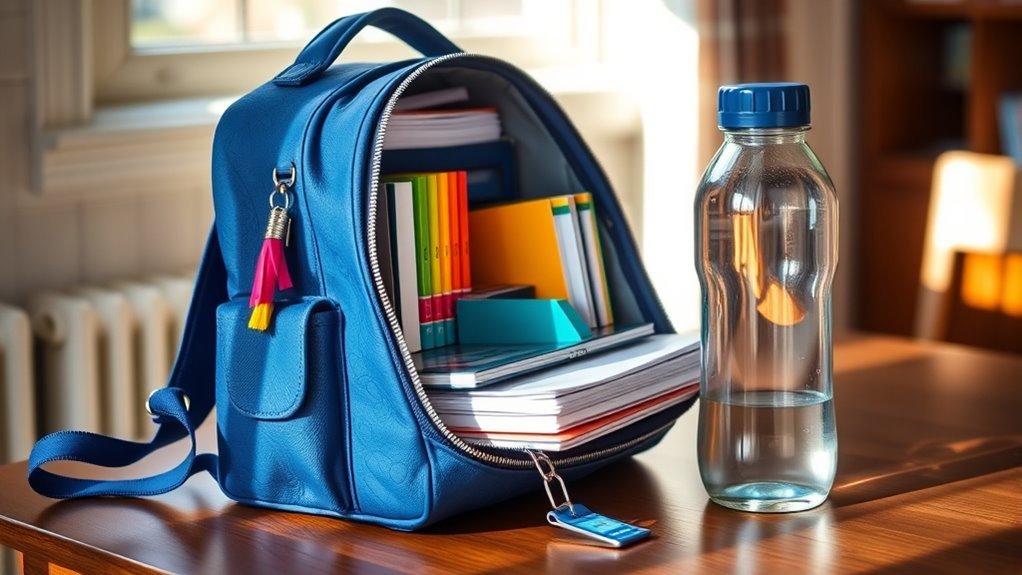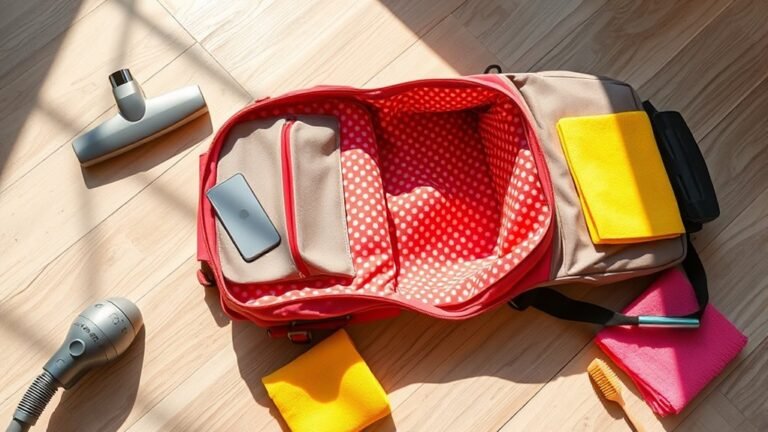Daily Maintenance Tips for School Bag
You should empty and shake out your school bag daily to remove crumbs and debris, then wipe it with a damp cloth to keep it fresh. Organize essentials like notebooks and snacks in separate pockets to avoid clutter and protect your bag’s shape. Use waterproof sprays or covers to guard against rain, and check zippers regularly for smooth use. Proper storage in a dry spot also helps maintain durability. Keep these simple habits up, and you’ll find even more ways to care for your bag.
Regular Cleaning Techniques

To keep your school bag in good shape, you should clean it regularly—ideally once a week. Sticking to a consistent cleaning frequency prevents dirt buildup and keeps your bag fresh. Start by emptying everything out and shaking loose crumbs or debris. Use a gentle brush or cloth to wipe the exterior. For fabric bags, a mild detergent mixed with water works well; just be sure to test maintenance products on a small area first to avoid damage. Avoid harsh chemicals that can wear down materials or colors. Let your bag air dry completely before using it again. Keeping up with these regular cleaning techniques not only extends your bag’s life but also lets you enjoy your freedom to move without the hassle of a dirty, smelly school bag.
Organizing Your School Bag Efficiently
You’ll want to keep only the essentials in your school bag to avoid unnecessary weight. Using compartments wisely helps you find items quickly and keeps everything in place. Organizing this way makes your bag more efficient and easier to maintain.
Prioritize Essential Items
Although it might be tempting to pack everything you think you might need, focusing on essential items will make your school bag lighter and more manageable. You don’t want to be weighed down by unnecessary stuff—freedom means moving easily and staying organized. Start by identifying your essential supplies: notebooks, pens, and any materials needed for the day’s classes. Include daily essentials like your wallet, phone, and a water bottle, but leave behind extras that rarely get used. When you prioritize what truly matters, you’ll avoid clutter and stress. Keeping only what’s necessary helps you stay flexible and ready for whatever the day brings, so your bag supports your goals rather than holding you back. Stay focused, pack smart, and enjoy the ease that comes with less.
Use Compartments Strategically
Many school bags come with several compartments designed to help you stay organized and access your items quickly. Knowing the compartment types and their strategic placement lets you pack smartly, giving you the freedom to find what you need without hassle. Use smaller front pockets for essentials like keys or earbuds, main compartments for books, and side pockets for water bottles. This setup keeps your bag balanced and your day stress-free.
| Compartment Type | Items to Store | Benefit |
|---|---|---|
| Front Pocket | Phone, Keys | Quick access |
| Main Compartment | Books, Notebooks | Secure, spacious |
| Side Pocket | Water Bottle, Snacks | Hydration on-the-go |
Using compartments strategically makes your school bag a tool for freedom, not frustration.
Protecting Against Weather Damage

One simple way to protect your school bag from weather damage is by using waterproof sprays or covers. These waterproof coatings create a barrier that keeps rain and moisture from seeping into your bag, preserving its fabric and contents. When choosing a new bag, look for weather resistant materials like nylon or polyester, which naturally repel water better than cotton or canvas. You don’t have to limit yourself—these materials offer durability without sacrificing style or freedom of movement. If you’re caught in unexpected weather, a quick cover-up with a waterproof layer can save you from damage and hassle. Taking these small steps means your bag stays reliable and ready, so you’re free to focus on your day without worrying about soggy books or electronics.
Handling Stains and Spills
Stains and spills happen, especially when you’re juggling snacks, drinks, and school supplies. To keep your school bag looking fresh, quick stain removal is key. Blot spills immediately—don’t rub—and use a damp cloth with mild soap for stubborn stains. For spill prevention, consider waterproof organizers or pouches inside your bag. Here’s a quick guide to tackle stains and prevent spills:
| Spill Type | Best Action |
|---|---|
| Juice | Blot, mild soap, air dry |
| Ink | Rubbing alcohol, blot gently |
| Mud | Let dry, brush off, clean |
| Oil-based stains | Baking soda, mild detergent |
Taking these steps helps you maintain a clean bag without hassle, freeing you to focus on your day.
Checking and Repairing Zippers

You’ll want to regularly check your school bag’s zippers for any signs of damage like stuck sliders or missing teeth. If you notice a problem, there are quick fixes you can try, such as lubricating the zipper or realigning the teeth. Taking care of these issues early can keep your bag functioning smoothly.
Identifying Zipper Issues
Although zippers are designed to be durable, they can sometimes get stuck, misaligned, or break, which can make your school bag difficult to use. To enjoy the freedom of smooth access, you need to identify zipper issues early. Regular zipper maintenance helps prevent the need for zipper replacement. Check for signs like missing teeth or slider damage, and don’t ignore any stiffness or catching.
| Issue | What to Look For |
|---|---|
| Stuck Zipper | Slider won’t move smoothly |
| Misaligned Teeth | Teeth don’t close properly |
| Broken Slider | Slider is loose or missing |
| Missing Teeth | Gaps in zipper teeth |
| Fabric Caught | Material stuck in zipper |
Spotting these problems early keeps your bag functional and hassle-free.
Quick Zipper Fixes
When you notice your zipper acting up, quick fixes can save you time and frustration. First, check if dirt or fabric is stuck in the teeth—clean it gently with a soft brush. If the zipper feels stiff, apply a zipper lubricant to ease movement and prevent future jams. Sometimes, the slider gets misaligned; carefully realign it with pliers without squeezing too hard. However, if your zipper is broken beyond repair or missing teeth, a zipper replacement might be necessary. Don’t hesitate to swap out the zipper to keep your school bag functional and hassle-free. Taking these swift steps lets you maintain freedom of movement without the annoyance of a stuck or broken zipper. Keep your bag ready for anything by addressing zipper issues right away.
Maintaining Bag Straps and Handles
Since bag straps and handles take the most strain, it’s important to check them regularly for signs of wear and tear. You want your school bag to offer freedom, not frustration, so start by inspecting straps for fraying or loose stitching. Use strap adjustment to guarantee your bag fits comfortably, preventing unnecessary stress on seams. If you notice any weakness, applying handle reinforcement with strong adhesive or sewing can extend their life. Avoid ignoring small damages; a quick fix now saves you from bigger hassles later. Keeping your straps and handles in good shape means you can move freely throughout your day, carrying your essentials without worry. Regular care here is key to maintaining your bag’s durability and your daily ease.
Avoiding Overloading Your Bag
Carrying too many items in your school bag can quickly lead to discomfort and damage. To keep your bag in top shape and enjoy freedom of movement, you need to monitor bag weight and guarantee proper load distribution. Avoid stuffing everything in; instead, pick only what you truly need each day. Balancing the load helps prevent strain on your shoulders and extends the life of your bag.
| Item Type | Importance | Weight (approx.) |
|---|---|---|
| Textbooks | High | 3-4 lbs |
| Stationery | Medium | 1 lb |
| Electronics | Variable | 2-3 lbs |
Storing Your Bag Properly When Not in Use
When you’re not using your school bag, make sure to store it in a dry spot to prevent mold and damage. Avoid overcrowded areas where your bag can get squished or misshaped. Taking these simple steps will help keep your bag in good shape for longer.
Choose a Dry Spot
Although you might be keen to toss your school bag anywhere after a long day, choosing a dry spot for storage is essential to keep it in good condition. Moisture control and proper ventilation prevent mold, bad odors, and fabric damage. Avoid damp corners or places prone to humidity. Instead, find a spot that feels airy and dry to help your bag breathe.
| Benefit | Reason |
|---|---|
| Mold Prevention | Dry environment reduces mold growth |
| Odor Control | Proper ventilation avoids smells |
| Fabric Longevity | Moisture weakens materials |
| Easy Access | Dedicated dry spots keep bags ready |
| Cleanliness | Dry spots limit dirt and grime |
Picking the right place means your bag stays fresh, durable, and ready for your next adventure.
Avoid Overcrowded Areas
Since bags need space to keep their shape and avoid damage, you shouldn’t store yours in overcrowded areas. Crowded hallways and bus congestion can crush your bag, causing wear and tear. To protect your school bag and keep your freedom to move, follow these simple tips:
- Choose a spot away from heavy foot traffic to prevent accidental bumps.
- Avoid placing your bag near doorways or tight spaces where it might get squished.
- Use hooks or lockers designed to give your bag enough breathing room.
Using Protective Accessories for Longevity
To keep your school bag in great shape, you should invest in protective accessories that shield it from daily wear and tear. Waterproof covers are a must-have; they guard your bag against unexpected rain or accidental spills, letting you move freely without worry. Cushioning pads add extra support, absorbing shocks when you drop or bump your bag, preventing damage to both the bag and its contents. These accessories not only extend your bag’s life but also give you peace of mind as you go about your day. By using waterproof covers and cushioning pads, you protect your investment and maintain the bag’s appearance and function. It’s a simple way to enjoy freedom without constantly stressing over your gear.
Scheduling Routine Inspections
When you make a habit of checking your school bag regularly, small issues can be caught before they turn into big problems. Setting a consistent inspection frequency helps you stay on top of wear and tear without feeling overwhelmed. Use checklist reminders to keep your routine simple and effective. Here’s a quick guide to scheduling your inspections:
- Weekly: Quickly scan for any obvious damage or dirt buildup.
- Monthly: Inspect zippers, straps, and seams for signs of weakening.
- Quarterly: Deep clean and repair minor issues before they escalate.
Frequently Asked Questions
Can I Machine Wash My School Bag Safely?
You might be wondering if you can machine wash your school bag safely. It really depends on the bag material. Some fabrics, like cotton or polyester, handle machine wash well, but others, like leather or delicate synthetics, don’t. Always check the care label first. If it’s safe, use a gentle cycle and cold water to keep your bag looking fresh without damage. That way, your freedom to clean won’t come with risks!
How Often Should I Replace My School Bag?
Imagine carrying your school bag like a trusty satchel through a medieval marketplace—it should last, but not forever. You should replace your school bag every one to two years, depending on school bag longevity and how well you’re choosing materials. Durable fabrics like canvas or leather extend its life, giving you freedom from constant replacements. If it starts tearing or losing shape, it’s time for a fresh start, so you can roam unburdened.
Are Leather School Bags Better Than Fabric Ones?
When choosing between leather and fabric school bags, consider leather durability—it’s tough and ages well, giving you long-lasting freedom from frequent replacements. However, leather can be heavier and needs conditioning. Fabric bags offer lighter weight and easier fabric maintenance, letting you clean them quickly and enjoy a carefree style. Ultimately, it’s about your lifestyle: if you want rugged, go leather; if you prefer flexibility and easy care, fabric’s your pick.
Can Scented Sachets Prevent Odors in My Bag?
You’re wondering if scented sachets can help with odor prevention in your bag, right? They actually can! Scented sachets absorb moisture and release a pleasant fragrance, keeping your bag fresh and free from unwanted smells. Just toss one inside, and you’ll enjoy a subtle scent without overpowering your stuff. It’s a simple, natural way to maintain freedom from bad odors, letting you carry your bag confidently every day.
What’S the Best Way to Disinfect My School Bag?
You don’t want your school bag turning into a germ jungle, right? The best disinfecting methods depend on your bag materials. For fabric, mix mild soap with water and gently scrub, then air-dry like your bag’s on a tropical vacation. For leather or synthetic, use a disinfectant wipe or spray designed for those surfaces—don’t soak it! This way, you keep your bag fresh without sacrificing its freedom to roam wherever you go.






